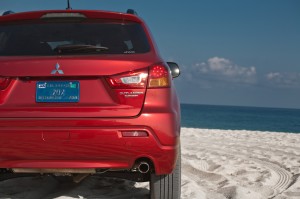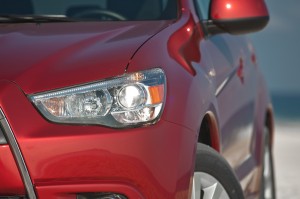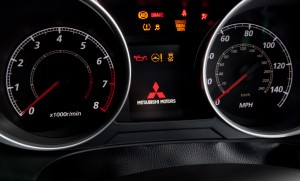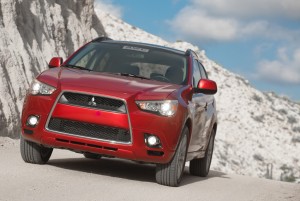
The Mitsubishi Outlander Sport shows Mitsubishi is more focused on its future products than its current lineup.
It’s a familiar tactic, one employed by automakers the world over. Instead of coming up with a new name to attach to its latest offering, the marketeers just use the name from another vehicle with some sort of appendage.
So, even though Mitsubishi’s new compact sport utility is mostly different from the company’s larger offering, it still gets the same name, Outlander. For the smaller ute, Mitsubishi adds “Sport” to the name.
The Outlander Sport looks the part. Leading with Mitsubishi’s corporate “shark-nose” front end, the Sport has a decidedly taut design. Remember the days when forward-leaning front ends were the in design? Think Buick Century as well as generations of BMWs. That look gave way to the swept-back, aerodynamic look. But now, the forward lean is back. Even if it doesn’t seem aerodynamic, that’s an optical illusion because Mitsubishi claims a coefficient of drag of 0.33, which is rather remarkable for any sport ute, forward leaning snout or not.
The interior is pretty much standard-issue Mitsubishi, which means a lot of black, some decent materials, some poor ones, but still rather stark. Mitsubishi would do well to invest in glitzier interiors than most of its cars have. At least the automaker has finally installed a USB plug to attach an iPod, a seemingly critical component for an automaker that targets Gen Y buyers. Right next to the USB located in the center console storage bin are Mitsubishi’s typical RCA-style jacks, something few other cars use to connect mp3 players to the infotainment system. A simple auxiliary jack would be better.
The Sport is 15 inches shorter than the regular Outlander, so there is no optional pop-up third-row seat as is offered in the larger vehicle. It also sacrifices a large amount of cargo space. The Sport has 21.7 cubic feet behind its second row, compared to 36.2 for the original Outlander.
The Sport comes in three trims, base ES, the up-level SE and SE AWC. All-wheel control is Mitsubishi-speak for all-wheel drive. The ES starts at $19,275, including destination. The SE starts at $22,475 and adds high-intensity discharge headlights, push-button start, 18-inch aluminum wheels, automatic climate control, magnesium paddle shifters. AWC adds $1,300 but is only available on the SE.
This Sport came with a $1,800 premium package, which includes a massive panoramic sunroof with cool LED trim lights around the edge of the sunroof, black roof rails, a 710-watt Rockford Fosgate stereo with nine speakers including a subwoofer and Sirius satellite radio. Navigation including real-time traffic with a rearview camera and 40-gig music server adds $2,000. Lastly, an exterior sport package adds a rear spoiler, front corner extensions, rear diffuser, front chrome diffuser and an alloy fuel door for $995, bringing the total to $28,570.
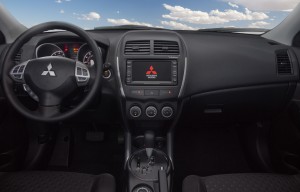
The Outlander Sport's interior is similar to other Mitsubishis. It has a young feel, in keeping with the youth market Mitsubishi targets.
While it’s a good-looking package, the Sport amounts to a lot of flash, but not much actual sport. The engine is surprisingly buzzy considering this is the company that holds the patent for engine balance shafts. The engine thrash doesn’t result in much accelerative force, either.
Part of that has to be attributed to the continuously variable transmission. Like some other cars with CVTs, the Sport offers the option of manually “shifting” the transmission. The Outlander Sport borrows magnesium shift paddles from the Lancer Evolution and it also has a slot to the left of the main shift pattern to manually shift it through six “gears,” as well. For some reason, the Sport feels like it has more power when shifted manually. Weird. Better to stick with the standard five-speed stick, but it’s only available in the ES.
One particularly interesting feature is a regenerative braking system similar to that used on hybrid vehicles. The Sport isn’t a hybrid, so instead of recharging a battery for the drive system, it recharges the car battery, reducing the strain on the vehicle’s alternator. It works seemlessly, with none of the grabbiness associated with early versions of this type of system.
The engine is Mitsubishi’s familiar 2.0-liter with variable valve timing. In this tune, it produces 148 horsepower, and it’s pulling 3,263 pounds in SE AWC trim, so that it’s not all that quick isn’t surprising.
But worse than the weak-kneed engine, is the Outlander Sport’s poor suspension tuning. The ride tends toward stiff, but there’s not much reward in sporty transient responses. It’s most overt trait is the way it becomes unsettled in bumpy turns, a common problem in vehicles from less-accomplished automakers. At least there’s no torque steer, even in the front-wheel drive setting.
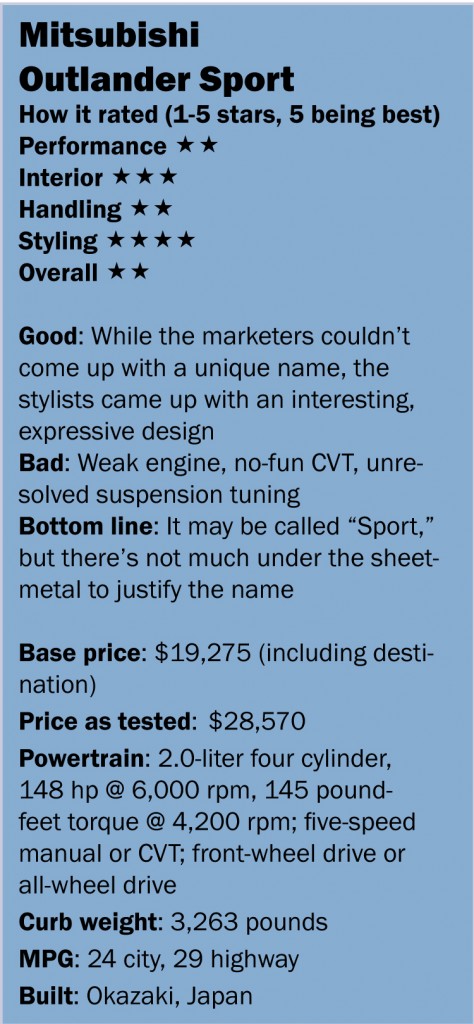 The AWC system has three settings – front-wheel drive, four-wheel drive and lock. Some automakers have said that their research shows that many drivers don’t know when to use which setting. All-wheel drive systems that operate seamlessly make more sense for most drivers.
The AWC system has three settings – front-wheel drive, four-wheel drive and lock. Some automakers have said that their research shows that many drivers don’t know when to use which setting. All-wheel drive systems that operate seamlessly make more sense for most drivers.
With the weak engine, economy-minded CVT, and part-time all-wheel drive, one might expect fuel economy to be a strong suit. It’s rated at 24 city and 29 highway, but we saw just 22, on mostly clogged freeways and rural two-lanes. It needs to do better.
Mitsubishi also needs to do better with certain interior bits. The dials for the automatic climate control feel and look cheap. The sliding center armrest lacks an indent to hold it in the forward position. The seats cushions are comfortable, but the seatbacks have too much lumbar, although it’s not adjustable. The sun visors are chintzy vinyl.
Details such as those make many of Mitsubishi’s cars frustrating. For every stroke of brilliance – the entire driving experience of the Evo, let down by its econocar interior; the Outlander Sport’s gorgeous styling, betrayed by poor suspension tuning and a disappointing transmission – there’s another detail that makes you say “What were they thinking?”
One note about the Sport: Mitsubishi says that the vehicle will be built at its plant in Normal, Ill., but this one came from Japan.
Mitsubishi is an automaker in transition. The company’s future product plans focus on small, electric vehicles such as the upcoming Mitsubishi i. It’s a radical program for an often-troubled automaker with a checkered past filled with scandal, corruption and some lackluster cars sprinkled with sheer brilliance.
In the meantime, Mitsubishi continues to sell its familiar mix of low-priced sedans, coupes and crossovers aimed at the younger crowd. But it’s obvious that the company’s attention is focused more on what’s next instead of what’s now.

